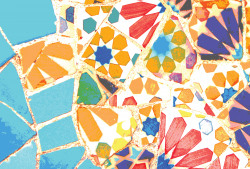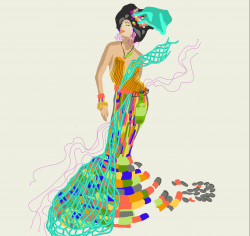The soft strings of a cello draw the viewer into a dark gallery. This tranquil greeting opens “Days of Endless Time,” the Hirshhorn Museum’s new moving-image exhibition that explores the slowing and suspending of time to counteract the speed of the technological age. When you enter the gallery, time becomes irrelevant, and the whole experience is a single moment of infinite stillness.
After passing the source of the music, a video of an artist playing the cello on the edge of a Valley in the Alps, Sigalit Landau’s “DeadSee,” comes into view. In the video, the artist floats on the Dead Sea in the middle of a coiled chain of watermelons. On the screen emerges a green spiral, slowly unfurling like a spring fern. The artist’s naked body comes into view, curled around one of the concentric rings of the spiral.
With her left arm pressed against her body and her right arm reaching above her head, she clings to a red, gashed watermelon, shocking against the green spiral and the steely blue water. The spiral suddenly gets down to two rings, then just one, leaving the artist exposed on the edge. The final circle unfurls and is pulled off screen, Landau upside down slowly trailing along behind it, until only the rippling blue grey water is left, ruffling in the wind that blows over the Dead Sea.
Time flies when you’re having fun, or so the saying goes. Hans Op de Beeck’s 22-minute-long video, “Staging Silence,” is a foray into change and time, and engages your imagination to the extent that time really does fly. The artist constructs and destroys various building sets that he creates. The video begins with normal table objects: a thermos of coffee, two mugs, an ashtray, and a burning cigarette.
Beeck proceeds to turn the thermos into a building, adding stacked tupperware and other kitchen objects to create the skyscrapers of a city. Perhaps the most powerful transformation is the palace garden, which includes a fountain, hedges, gazebos, and a stairway to a building. We see Beeck take away the hedges and fountain, see him cut away slices of the cake-palace, see the foundations fall into ruin, and trees grow up next to the wreckage. At the end of the video, the trees turn into a forest, transitioning into a winter wonderland when Beeck sprinkles white sand into “snowdrifts” and brushes away patches to create a frozen river.
Nature’s ability to set you into a serene rhythm is a prevalent idea throughout many of the exhibit’s works. This theme is clear in the tranquil floating on the Dead Sea, as it also is through the awe-inspiring echoes of the Alps. Perhaps the most obvious use of nature to create a meditative state is David Claerbout’s “Travel,” a 13-minute-long video of soothing forest scenes. The most daring of the many artworks was Guido van der Werve’s “The Day I Didn’t Turn with the World,” a series of stills from 24 hours that he spent standing and turning at the North Pole.
The thread that binds these thematically disparate works is their meditativeness, and the temporal suspension that occurs as you stand before each one—a reflective relief from the effects of the Age of Technology. The world is faster now, and people are more productive, but have less time.
Sitting in front of these images helps viewers slow down and slip into a sublime state of calm and awareness. External stresses fade and viewers focus solely on being an observer, and nothing else. In the exhibit, one feels completely natural in the dark and muffled gallery rooms, yet only upon re-entering the bustling, noisy outside world can viewers fully appreciate the power of nature, of silence, and of stillness.
Hirshhorn Museum
7th St. & Independence S.W.
Mon. – Sun., 10 a.m.– 5:30 p.m.
hirshhorn.si.edu





